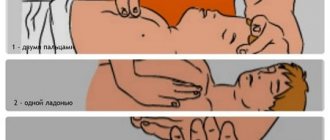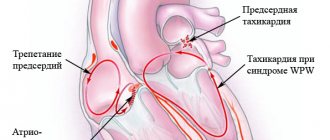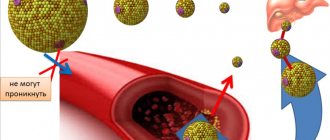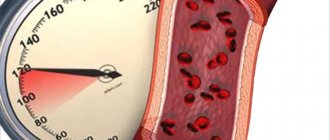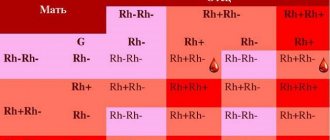Symptoms of cardiac and respiratory arrest
Simple steps will help determine the functioning of the heart and respiratory system.
In this case, the following clinical signs are detected:
| Name | Description |
| No pulse | You can determine whether there are heartbeats or not by placing two fingers on your neck under the cheekbones. On the left side of the chin is the carotid artery. |
| Lack of breathing | You can listen to the work of the heart with your ear, placing it on your chest. You can also determine breathing with your hand by placing it on your chest in the area of your heart. Place a mirror near the victim's mouth. If it fogs up, there is breathing. |
| Pupil reaction | It is necessary to lift the eyelid and shine a flashlight on the pupil. If there is no reaction, then the heart has stopped. |
It is important to start artificial respiration immediately after a person loses consciousness and cardiac arrest.
First aid for respiratory arrest
In this case, assistance before the arrival of doctors consists of a set of measures. Specific techniques are determined depending on the factor that influenced the cessation of breathing:
- For bronchial asthma it is necessary to use an inhaler.
- In case of allergic strangulation, injections of antihistamines cannot be avoided.
- With prolonged absence of breathing, cardiac arrest occurs. To stimulate the functioning of the organ, indirect massage is performed along with artificial respiration (AR). If the pulse is palpable, it is enough to carry out ID.
Types of artificial respiration
In medicine, the following types of artificial ventilation are distinguished:
| Name | Description |
| Mouth to mouth | A classic resuscitation procedure performed for forced ventilation of the lungs. |
| Mouth to nose | Air is blown into the victim's lungs through the nose. At the same time, the person’s mouth closes tightly. |
| Manual artificial respiration | Resuscitation manipulations are performed according to the method of Schaeffer, Laborde, Howard, Kallistov, Frank Yves. |
| Automatic | Special equipment is used in inpatient facilities or by emergency doctors. |
| Tracheal intubation | A method of forced ventilation of the lungs, which involves inserting a special probe with a tube into the trachea. It is carried out in case it is impossible to restore the respiratory process using manual methods. |
| Tracheostomy | The procedure is performed in emergency situations. The doctor performs minor surgery to gain direct access to the trachea. |
Artificial respiration is performed when the victim cannot breathe on his own. The method of resuscitation measures is selected taking into account the person’s condition.
Restoration of blood circulation
Before starting chest compressions, the person providing assistance must perform a precordial blow, the purpose of which is to strongly shake the cell with the chest and activate the start of the heart.
The precordial blow must be delivered with the edge of the fist. The point of impact is located in the lower third of the sternum, or more precisely 2–3 cm above the xiphoid process. The blow is performed with a sharp movement, the elbow of the hand should be directed along the victim’s body.
If the precordial blow is applied correctly, the victim will return to life in a few seconds, his heartbeat will be restored, and consciousness will return. If the heart function is not activated after such a blow, resuscitation should be started (indirect cardiac massage, artificial ventilation of the lungs). These activities should be continued until the victim begins to pulsate, the upper lip turns pink, and the pupils constrict.
Interesting Purpose and equipment of pediatric intensive care in the maternity hospital
Indications and contraindications for first aid
Artificial respiration must be done in any situation when the volume of ventilation of the lungs is critically low. Cardiopulmonary resuscitation will ensure normal gas exchange.
There are the following indications for artificial respiration:
| Name | Description |
| Violation of central regulation of breathing | Malfunctions in the functioning of the respiratory system occur as a result of impaired cerebral circulation. The same thing happens against the background of malignant tumors or after a brain injury. |
| Poisoning of the body | We are talking about drug intoxication or poisoning of the human body by other methods. |
| Damage to the neuromuscular synapse, nerve pathways | The pathological condition most often occurs against the background of a trauma to the cervical spine, a viral infection, or as a result of poisoning of the human body. The same thing occurs after taking certain medications that have a toxic effect. |
| Hypoventilation of the lungs | A pathological condition characterized by incomplete ventilation of the lungs. Blood oxygenation is disrupted and the removal of carbon dioxide from the human body becomes difficult. |
| Bradysystole | The frequency of contractions of the heart ventricles decreases. |
Diseases and damage to the respiratory muscle and heart wall also require cardiopulmonary resuscitation. The same applies to obstructive and restrictive lung disease.
Artificial ventilation is also indicated if, after the administration of certain medications, a person’s breathing stops. This happens during the use of anesthesia during surgery.
As for contraindications to artificial respiration, there are no absolute prohibitions.
Among the contraindications are the following pathological conditions:
- extreme chronic cardiac failure;
- futility of cardiopulmonary resuscitation;
- renal, hepatic and respiratory failure;
- cardiac arrest due to a long and severe illness;
- injuries and damage to the body that are incompatible with human life;
- biological death of the victim.
There are limitations that affect the technique of resuscitation procedures (impaired venous return of blood, lung injury).
Rules for rescuing a person in cardiac arrest
In the event of cardiac arrest, it is necessary to begin resuscitation immediately, since every minute is important. First of all, you should immediately call an ambulance. Then perform artificial respiration and, if necessary, cardiac massage.
The algorithm of actions is as follows:
- Lay the person flat, back down.
- Place a cushion under your neck.
- Tilt your head back a little.
- Move the lower jaw forward.
- Remove all contents from the mouth (vomit, foam, mucus, foreign body).
- Perform cardiopulmonary resuscitation.
If 2 people provide assistance, it is important that each of them deals separately with the restoration of breathing and heart function.
mechanical ventilation
Mechanical ventilation is the second resuscitation method used together.
Before performing artificial respiration, the victim should restore patency of the airways. For this action, the victim is placed on his back, the head is tilted back as much as possible, and the lower jaw is pushed forward. The lower jaws, when extended, should be positioned at the level or in front of the upper jaws.
Interesting Algorithm of actions for indirect cardiac massage
Then the oral cavity is checked for the presence of foreign bodies (blood, tooth fragments, vomit). For personal safety, cleaning the oral cavity should be done with the index finger, on which a sterile napkin or handkerchief is wrapped. If the patient has a spasm of the masticatory muscles, the mouth should be opened using a flat, blunt object.
Then they begin artificial ventilation of the lungs. There are various ways to resuscitate breathing.
How to do closed cardiac massage and forced ventilation?
Closed heart massage and forced ventilation of the lungs are carried out if the victim has not only no breathing, but also no pulse. It is important to know certain rules for performing resuscitation procedures, since you can harm a person by blowing air into the wrong lungs.
Preliminary actions
Artificial respiration will save a person’s life if timely assistance is provided to the victim.
The following steps must first be taken:
- Place the person's back on a hard surface.
- Clear the airways.
- Tilt your head back slightly.
- Unbutton clothing to visually observe the chest.
- Assess the condition of the victim and begin resuscitation procedures.
Preliminary actions should not take more than 10 seconds. Taking into account the person’s condition, the most effective method of artificial respiration is chosen.
Artificial respiration from mouth to mouth
A common method of artificial respiration that can be performed even by a person who does not have a medical education.
Artificial respiration from mouth to mouth. How to do
To assist a victim in a critical situation, the following actions must be taken:
- The victim's oral cavity must be checked for foreign bodies. They should be removed with your finger, after wrapping it with a bandage.
- The tightly closed jaw is opened with the handle of a spoon or other flat object.
- Cover the unconscious person's mouth with gauze or a handkerchief that allows air to pass through. This is necessary to comply with simple hygiene and safety measures.
- The lips should be pressed as tightly as possible to allow more air into the lungs.
- It is recommended to inhale oxygen for 1.5-2 minutes.
- Pull back to let the air escape.
First aid procedures must be repeated 12-15 times per minute. One inhalation cycle should take no more than 4-5 seconds.
Artificial respiration from mouth to nose
The method of artificial respiration from mouth to nose is considered the most effective, since during the manipulation the entry of air into the stomach is completely eliminated.
It is recommended to perform artificial respiration as follows:
- It is necessary to fix the head of the injured person. Place one hand on your forehead and hold your chin with the other.
- The victim's mouth must be tightly closed to prevent oxygen inhaled through the nose from escaping.
- Take a deep breath and exhale air with maximum force into the victim’s nose.
- After taking a few breaths, you should check the person's pulse.
It is important to observe the chest, which will swell if all movements are performed correctly.
Features of the procedure in children
Cardiopulmonary resuscitation is more difficult for children, since there is a high probability of breaking the victim’s ribs. You should not hesitate with artificial respiration if the child does not show signs of life. The life of a small patient depends on the speed of providing first aid.
Artificial respiration should be given to the child through the mouth and nose, while performing indirect cardiac massage with two fingers or one hand.
Cardiopulmonary resuscitation in children involves the following actions:
- Open the chest.
- Clear the airways. Remove foreign objects from the mouth with your finger, after wrapping it with a bandage.
- Air should be blown into the child's respiratory tract for 1-1.5 seconds.
- Take 5 breaths, after each it is necessary to control the movement of the chest and allow oxygen to escape.
- If there is no reaction, repeat the manipulations.
- If the chest does not move, it means that there is a foreign object in the respiratory system that must be quickly removed. To do this, it is recommended to make 5 sharp blows with your hand between the shoulder blades to the side of the head. Then check your mouth again.
- If the chest moves, continue resuscitation efforts and move on to cardiac muscle massage.
- Press with your hand in the center of the chest. For newborn babies, heart massage is performed with two fingers. For fearful children, pressure is applied to the chest with one hand.
- It is necessary to press not hard, but often (100 times per minute). After every 30 pressures, it is necessary to continue artificial ventilation of the lungs with 2 breaths for 1-1.5 seconds.
All manipulations should be performed before the ambulance arrives. If the child has come to his senses, he should not be left alone. It is necessary to wrap him in a blanket and lay him on his side. Cardiopulmonary resuscitation may be needed again at any time.
Carrying out cardiopulmonary resuscitation together
Cardiopulmonary resuscitation is recommended to be carried out by two people, since manipulations require a lot of effort.
It is important to adhere to the following sequence:
- Kneel near the injured person and take a stable position.
- Immediately determine the pressure point.
- Cross your palms and place them on your chest, connect your fingers, straighten your arms.
- Make 30 strong compressions so that the chest drops 4-5 cm.
- Then take 2 breaths.
It is important to continue cardiopulmonary resuscitation until the ambulance arrives.
Determining the correctness of resuscitation
You can determine how correctly emergency assistance was provided by certain external signs:
- reaction of pupils to light;
- the skin acquires a pink tint;
- a pulse appears in the area of the peripheral arteries;
- the victim slowly comes to his senses and begins to breathe on his own.
In the absence of a positive effect, a person’s biological death occurs; many processes are irreversible; brain tissue dies. The first signs of rigor mortis appear, and after a while, cadaveric spots appear.
Method of mouth-to-nose artificial respiration
This option of artificial respiration is useful when the victim has a clamped jaw, teeth or lips are seriously injured.
The rescuer places one hand on the forehead, the other on the chin, thereby slightly squeezing the jaws so that subsequently the air does not escape through the mouth. Then take a deep breath. Exhalation is delayed. The rescuer leans over the victim and blows air through his nose, wrapping his lips around it. Then he lets go of his hands and moves away, allowing artificial exhalation to occur. Then the algorithm of actions must be repeated. There should be no more than 4 seconds between breaths.
Complications of artificial respiration
When a victim is on mechanical ventilation for a long time , the risk of negative consequences increases:
- air entering the stomach;
- when the air duct is inserted, vomiting occurs;
- possible damage to the mucous membrane;
- pneumothorax develops (air or gases accumulate in the pleural area);
- bilateral eustachitis (the mucous membrane of the auditory tube is affected by the inflammatory process);
- emphysema (a disease characterized by damage to lung tissue).
The blood supply to the kidneys, liver and spleen deteriorates. The muscles of the respiratory system atrophy, intracranial pressure increases. An incorrectly selected method of artificial ventilation of the lungs entails the development of acidosis and alkalosis. Careful hygiene of the respiratory system will help prevent possible complications of resuscitation.
Signs of success
Correct performance of cardiopulmonary resuscitation results in the following symptoms appearing in the victim:
- blood pressure increases;
- heart rate appears;
- spontaneous breathing is restored;
- pupils constrict;
- the skin becomes less pale.
It is recommended to perform resuscitation procedures for at least 10 minutes, or better yet, until an ambulance arrives. Even if palpitations appear, you should continue to perform artificial respiration for at least 1.5 hours.
How long does it take to resuscitate a person?
Artificial respiration should be performed for 30 minutes after the person has lost consciousness or cardiac arrest has occurred.
If there is no effectiveness after resuscitation procedures, vegetative death occurs.
Brain death is accompanied by characteristic clinical signs, including changes in the shape of the pupil. It narrows when you press on the eyeball.
World methods of artificial respiration
There are world-wide methods of artificial respiration that are performed manually. The volume of the chest changes due to applied external forces.
| Name | Description |
| Schaeffer method | A technique of artificial lung ventilation, which is used if a person has injured arms or was injured while in water. The victim is placed face down, head turned to the side. The rescuer kneels so that the person's body is between his legs. Place your hands on the lower chest, thumbs along the spine, and the rest on the ribs. When exhaling, you need to lean forward and compress your chest. When inhaling, return to the starting position. When performing manipulations, do not bend your arms at the elbows. |
| Laborde method | Use immediately after breathing stops. It is necessary to grab the victim’s tongue and pull it out with rhythmic movements. By simulating breathing movements, a person comes to his senses. The restoration of the respiratory process is indicated by the resistance of the tongue when performing the described manipulations. |
| Kallistov method | A simple and effective method for ventilation. The victim is placed face down. A towel is placed on the back in the area of the shoulder blades, the ends are brought forward under the arms. The rescuer holds the towel by the ends, raising and lowering the victim’s torso to a height of 8-9 cm. When lifting, the chest expands, the ribs rise, the position corresponds to inhalation. At the moment of lowering the victim's torso, the exhalation of oxygen is simulated. The towel can be replaced with a belt or scarf. |
| Howard's method | Place the victim on his back with a bolster. Place your hands behind your head, stretching them forward. Turn your head to the side, pull out your tongue and fix it. The rescuer sits on the thigh area, places his palms on the lower part of the chest, spreads his fingers. It is recommended to compress the chest to inhale and release it to exhale. It is necessary to perform 12-16 manipulations per minute. |
| Frank Eve's method | The artificial respiration method involves the use of a stretcher. They must be placed on a cross stand in the middle. The height should be no more than half the length of the stretcher. The victim is placed face down on them with his face turned to the side. Place your arms along your body. The person must be secured in the hips and buttocks to the stretcher. When the head end of the structure is lowered, an inhalation is made, when it rises, an exhalation is carried out. When tilted at 50 degrees, maximum breathing volume is observed. |
| Nielsen method | The victim must be placed on the floor with his stomach down. Turn your head to the side. Place your arms under your head so that they are bent and crossed. The person providing emergency assistance kneels. Use your palms to press on the chest in the area of the shoulder blades to exhale. Next, he takes the victim by the shoulders and lifts him up, inhaling. |
The effectiveness of such methods is significantly lower compared to the classical method of artificial respiration. In each case, great physical effort and effort is required. It will be hard for one person to cope with. But they still increase the chances of saving the victim.
Indirect cardiac massage (cardiopulmonary resuscitation)
How is NMS performed:
- find a hard, flat surface (floor, asphalt, long table) and place the patient on it, trying not to bend your back or move your neck (this is dangerous if a vertebral fracture has occurred);
- take a position on the side of the patient’s shoulders, sitting on your knees;
- place two palms (one on top of the other) at the junction of the ribs, which is located just below the nipples in the center of the sternum;
- apply pressure using not just force, but the weight of your own body;
- the sternum should drop by 40-50 mm, you cannot take your hands off the patient’s body between pushes;
- shocks per minute should be 80-100;
- Insufflations (artificial respiration) are 5 times less, that is, 15-20 per minute.
This technique is only relevant for adults. When rehabilitating children under one year old, you should use the technique indicated in the last section.
Please note: the pressure is applied not with bent, but with straight arms. This increases the pressure.
Typical mistakes in artificial respiration
Not everyone can do artificial respiration. If a person is not trained, he may make mistakes, which can be dangerous for the injured person.
Everyone should know about them:
| Name | Description |
| Delay in providing emergency assistance | Don't hesitate with first aid. There are 8 minutes left before the vital systems of the human body fail. |
| Incorrect sequence of artificial pulmonary ventilation (ALV) | First of all, it is necessary to clear the airways and clean the oral cavity. Weak tightness. The lips should be pressed as tightly as possible, only then the lungs will receive a sufficient amount of oxygen. |
| Wasting time | In some situations, they try to open the victim’s mouth, but this cannot be done. In this situation, it is necessary to begin resuscitation through the nose. |
| Long pauses between breaths, small volume of air blown in | A break is necessary for a short rest. Artificial respiration should be done quickly. Blow air for 1.5-2 seconds, 120 times per minute. |
| Lack of control | It is important to monitor the movement of the sternum. This is the first indicator that cardiopulmonary resuscitation is being performed correctly. |
| Simultaneous performance of mechanical ventilation and closed lung massage | In this situation, oxygen does not enter the blood. |
You don't have to be a professional to save a person's life. It is enough to master simple cardiopulmonary resuscitation skills so that the victim survives until the ambulance arrives.
Artificial respiration and cardiac massage do not always give positive results. Manipulations can be stopped if the victim shows no signs of life within 30 minutes after the start of resuscitation. That is why it is necessary to start artificial ventilation as early as possible, unless there are certain contraindications.
HOW LONG DOES ARTIFICIAL RESPIRATION BE CARRIED OUT?
There is only one answer to the question of how long ID should be carried out. You should ventilate your lungs in this mode, taking breaks for a maximum of three to four seconds, until full spontaneous breathing is restored, or until the doctor appears and gives other instructions.
At the same time, you should constantly ensure that the procedure is effective. The patient's chest should swell well, and the facial skin should gradually turn pink. It is also necessary to ensure that there are no foreign objects or vomit in the victim’s respiratory tract.
Please note that due to the ID, the rescuer himself may experience weakness and dizziness due to a lack of carbon dioxide in the body. Therefore, ideally, air blowing should be done by two people, who can alternate every two to three minutes. If this is not possible, the number of breaths should be reduced every three minutes so that the person performing resuscitation normalizes the level of carbon dioxide in the body.
During artificial respiration, you should check every minute to see if the victim’s heart has stopped. To do this, use two fingers to feel the pulse in the neck in the triangle between the windpipe and the sternocleidomastoid muscle. Two fingers are placed on the lateral surface of the laryngeal cartilage, after which they are allowed to “slide” into the hollow between the sternocleidomastoid muscle and the cartilage. This is where the pulsation of the carotid artery should be felt.
If there is no pulsation in the carotid artery, chest compressions in combination with ID should be started immediately. Doctors warn that if you miss the moment of cardiac arrest and continue to perform artificial ventilation, it will not be possible to save the victim.
Read also Hypothermia - causes, symptoms, diagnosis and treatment
